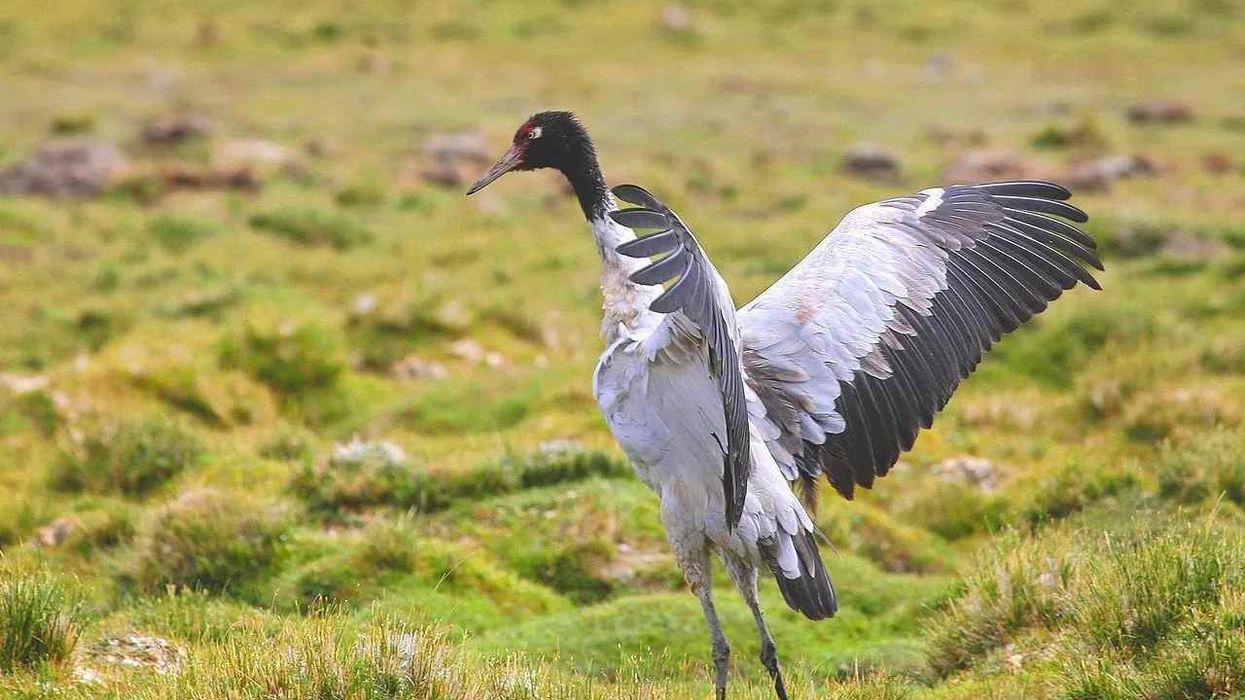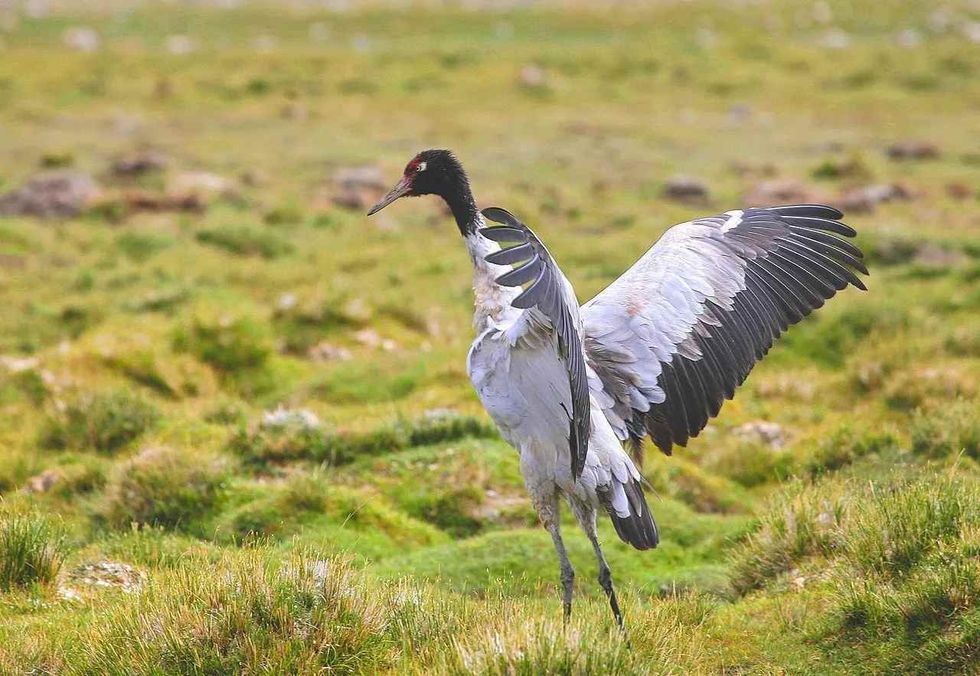Black necked cranes are Near Threatened species who live in the Tibetan plateau in China. They are also found in Bhutan and northern parts of India.
They have black head and upper neck area with a red colored crown. The rest body is white-gray in color with a black bushy tail. They have long thin legs like all other cranes.
Their length range is 55 in (140 cm) and weigh is around 12 lb (5.5 kg). They are omnivorous species who eat both insects and plant materials. These cranes are monogamous and form strong pair that last minimum up to a year.
Their litter size has two eggs with incubation period of 30-35 days. They are beautiful and one of a kind species who are legally protected in India and China.
This was just a small introduction. There are lots of interesting and funny facts about this bird in the sections below. So keep reading!
For more relatable content, check out these Siberian crane facts and red crowned crane facts for kids.
Black-Necked Crane Interesting Facts
What type of animal is a black-necked crane?
The black-necked crane (Grus nigricollis) is a type of bird.
What class of animal does a black-necked crane belong to?
Black-necked cranes belong to the class Aves, order Gruiformes, family Gruidae and genus Grus. The binomial nomenclature of this species is Grus nigricollis.
How many black-necked cranes are there in the world?
Black-necked cranes are considered as Near Threatend crane species. Their population is estimated between 8000-11000 individuals in the world. Due to their falling numbers, black-necked cranes are now protected in China and India.
Where does a black-necked crane live?
Black-necked crane (Grus nigricollis) can live in both higher and lower altitudes. They live in alpine meadows during their breeding season. In other time, majority of the species are found in China near different rivers. They eat on ground can be seen happily roaming there.
What is a black-necked crane's habitat?
Black-necked crane habitat range includes China, Bhutan, Nepal and northern parts of India. They mostly live near rivers and feed on ground. During their breeding season, they move towards the north to the alpine meadows and nearby marshes and river valleys.
Who do black-necked cranes live with?
Black-necked cranes are social birds who live in both high altitude areas and low altitude areas. They are seen in small groups feeding on ground. During winter, they migrate in groups also.
How long does a black-necked crane live?
The estimated life range of black-necked cranes is between 20-30 years.
How do they reproduce?
Black-necked cranes are oviparous animals who nest during May. According to several studies, they are considered as monogamous bird species. Their pairs last up to a year.
Both parents together build the nest and nurture their chicks. The breeding areas mostly being the high altitude plateaus.
After breeding, the mother crane lays two eggs, out of which only one egg survives (in most of the cases). The laid eggs go through an incubation period of 30-35 days and then the chicks come out. Both the parent birds take care of their young ones.
What is their conservation status?
The conservation status of these birds according to the IUCN red list, falls under the category of Near Threatened. There are around 8k-11 k black cranes available in this world.
Black-Necked Crane Fun Facts
What do black-necked cranes look like?
Black-necked cranes are elegant looking bird species from the Tibetan plateau and nearer places. They have beautiful color combos on their body.
As the name suggests, they primarily have a black head and upper neck with a red crown area. The lower neck and their under body is mostly white in color.
The dorsal or the back area is kind of whitish gray in color with black and white patch on the area in front of their tail. They have a bushy tail which is again mostly black in color. All these colors together give this bird an aesthetic touch.
For the body features, they have a narrow long neck and a small head. The body are area is comparatively bigger and had a bushy tail attached to it.
They have long thin legs to easily walk on the marshy areas and have long beak to easily catch their prey. The legs are dark in color and they beak is grayish in color.

How cute are they?
They are elegant looking birds who happen across the Tibetan Plateau. Their aesthetic color patterns on their body will make anyone fall in love with them.
How do they communicate?
These cranes generally communicate through small nasal calls. They bear a very calm nature but are highly territorial during nesting and chase away any intruding similar species with loud calls.
How big is a black-necked crane?
Black-necked cranes are big birds found mainly in China and in some areas in northern India and Bhutan. Their estimated average body length range is 55 in (140 cm) and their body weight is around 12 lb (5.5 kg). They have a magnificent wingspan range of around 7.8 ft (235 cm) and all these features contribute to its beauty.
How fast can a black-necked crane move?
They can both fly and run at a good speed but their exact flying or running speed is not recorded yet.
How much does a black-necked crane weigh?
Black-neck cranes are big bird species who grow to a length of 55 in (140 cm) and can weigh around 12 lb (5.5 kg).
What are the male and female names of the species?
There are no specific names given to these male and female crane species.
What would you call a baby black-necked crane?
Like all other baby birds, baby black-necked cranes are also called as chicks.
What do they eat?
Black-necked crane food is derived from both plant and animal materials. They are primarily omnivorous in nature. The things that they love to eat are plant roots, insects, earthworms, grains and vegetables. Other than this, they also eat frogs and other small vertebrates.
Are they dangerous?
No. They are harmless and tranquil natured species who cause no physical harm to humans.
Would they make a good pet?
No at all. Black-necked cranes are migratory big birds who live in the open wild. If they are kept as pets in a confined area, they won't survive. In China, India and Bhutan they are legally protected so keep them as pet would be illegal.
Did you know...
Black-necked cranes are found in northern parts of India.
Black-necked cranes are Near Threatened species and not Extinct species.
Why is the black-necked crane endangered?
The black-necked crane (Grus nigricollis) population is going down because of different reasons. One of the prime reason is habitat loss or habitat modification. Their population is also decreasing because of the predators like wild dogs and leopards who eat the young birds. Ravens are known to eat their eggs often.
Still the black-necked crane adaptation to its habitat is very good. They are legally protected in China and India. Their population is taken care of and are doing well now.
Comparisons with other cranes
Compared to most other cranes, black-necked cranes are bigger in size and have huge wings which they use for flying for thousands of miles during their migration. They have unique color patterns on their body that makes them attractive. And have many more internal adaptations to help them survive in both higher and lower altitudes.
Here at Kidadl, we have carefully created lots of interesting family-friendly animal facts for everyone to discover! For more relatable content, check out these painted bunting facts and shrike facts pages.
You can even occupy yourself at home by coloring in our free printable crane coloring pages.








